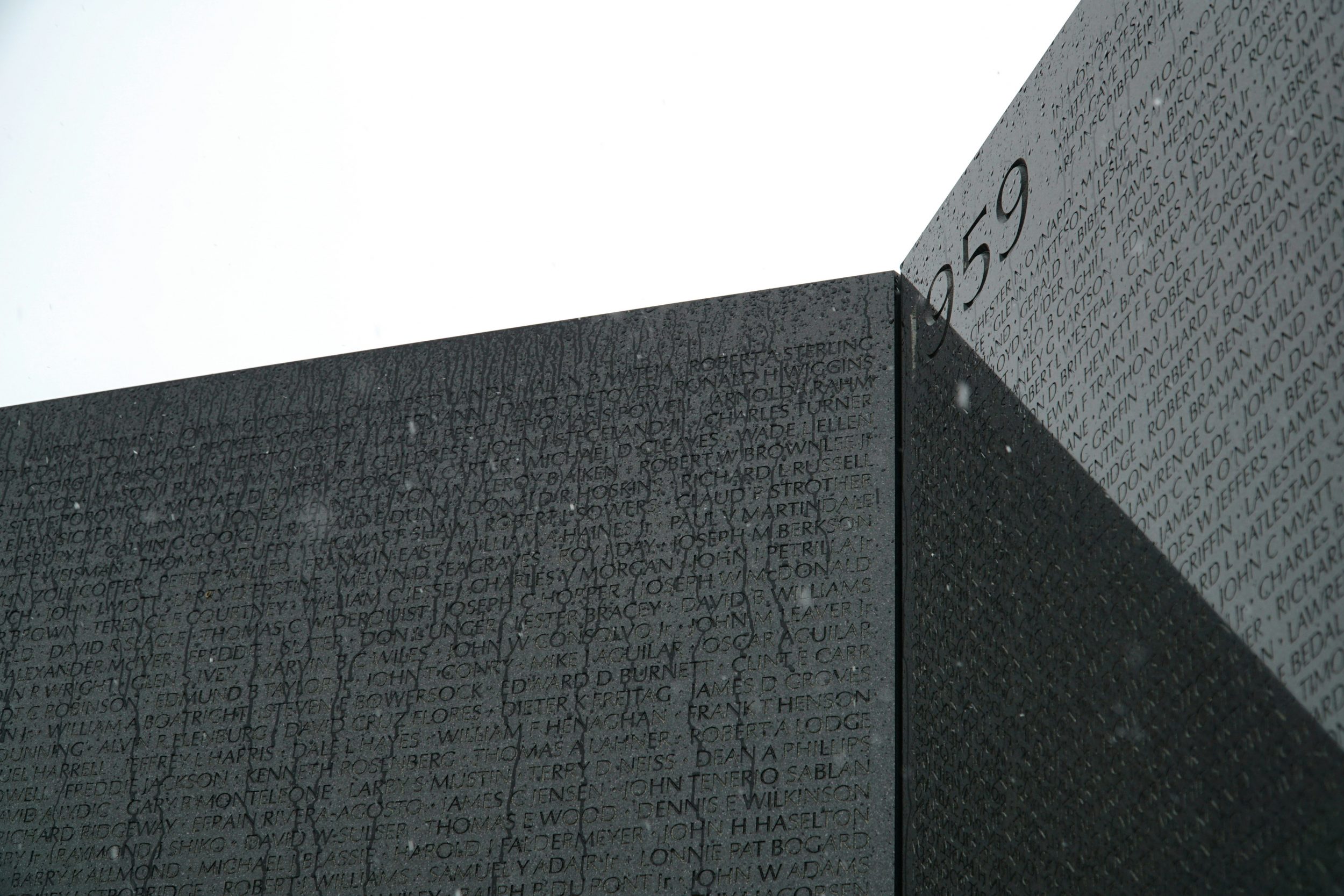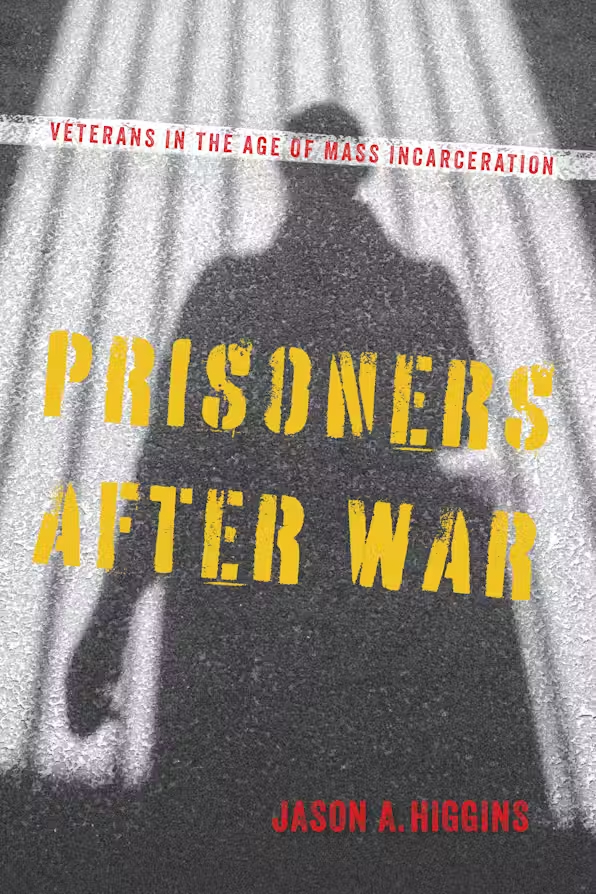Iraq War veteran David Carlson lives in the wake of intergenerational trauma, American wars, and incarceration. “My dad is from Mississippi. He’s my Black side,” Carlson says. “He was also an infantryman. After Vietnam, he got into a criminal lifestyle.” David’s father, Abra Hayes, had a brutal life in the Jim Crow South, living under the yoke of white supremacy. Carlson vividly recalls his father’s cautionary tale, warning him of the inherent dangers of being a Black man in America. During his childhood, young Abra witnessed the lynching of a Black man who—along with more than forty-four hundred victims of racial terror—was denied the constitutional right of due process and equal treatment under the law.
Born in Mississippi after the Second World War, Hayes grew up amid the intergenerational poverty and hardship of the sharecropping system with few opportunities for education—separate, unequal, or otherwise. Children went to segregated schools outside of the harvesting season, if at all. Most worked the cotton fields from dawn to dusk, laboring away their most formative years in the blistering Delta sun. Because their families were perpetually indebted to white landowners, Black children were funneled into a system of economic exploitation that functioned, in practice, like plantation slavery, creating generation after generation of poor, landless farmers with few rights and little opportunity.
Historically, the military could provide a path toward liberation. Along with tens of thousands of other poor, semiliterate Black men, Abra Hayes was drafted during the Vietnam War under the guise that the Army would provide opportunities for education, careers, and socioeconomic uplift. Project 100,000 enlisted men who, like Hayes, had attended segregated schools, scored lower than average on entrance exams, and desperately needed the bonuses awarded for combat service. But, like 94 percent of men recruited under Project 100,000, Abra Hayes received neither specialized training nor further education. Instead, after Vietnam, he returned to the Delta Mississippi where all the old systems of racial inequality and caste remained, carrying home more problems than before.
Carlson recounted his father’s experience: “They were extremely poor. He went to Vietnam and got shot. He had a hard time coming home.” After the war, Hayes migrated out of the South, seeking work and opportunities, but, as many other African Americans discovered, he could not completely escape the structural barriers that restrict Black life in America. Repressing the memories of combat in Vietnam, Hayes self-medicated. “He moved to California because it was a little better for Black people,” Carlson says, but “he could never beat the alcohol and drug addiction.” Hayes survived outside the law, hustling and inevitably harming his own family. His son, David Carlson, would be incarcerated by age fourteen and imprisoned again after two combat tours in Iraq.
Even though incarceration affects veterans of all racial groups in the United States today, the central location of incarcerated veterans in the twentieth century is African American history. Wars—and the power vacuums they create—generate great geographic and social movement among Black families. In the twentieth century, generations of Black men volunteered or were drafted in the tens of thousands to serve a nation that treated them as second-class citizens. To those denied citizenship, wars were rites of passage, battlefields upon which manhood was proven and destroyed. More often than not, youthful hopes of equal treatment and opportunity were choked against the walls of white supremacy in the military and beyond.
At these flashpoints in American history, Black veterans were caught in a crossfire of state-sanctioned violence. The First and Second World Wars enabled the great migrations but were followed by the Red Summer and the Red Scare, both of which targeted African Americans who demanded jobs and equality. The internationally publicized stories of Black World War II veterans—who were being beaten like Isaac Woodard, executed by police like Timothy Hood, or lynched like John C. Jones—forced the federal government to desegregate the armed forces, yet institutional racism and injustices continued throughout the Cold War.
More from our decarceral brainstorm
Every week, Inquest aims to bring you insights from people thinking through and working for a world without mass incarceration.
Sign up for our newsletter for the latest.
Newsletter
African Americans were unfairly arrested and faced excessive charges with inadequate legal counsel. Many were court-martialed, sentenced to lengthy sentences in military prisons, or executed. Thurgood Marshall and the National Association for the Advancement of Colored People (NAACP) investigated racial injustice in the military in the 1950s. They found that segregation continued, in practice, in the Army, and Black troops were held to a different and nearly impossible standard. For example, both white and African American troops retreated in battle during the Korean War, but 90 percent of the soldiers accused of cowardice were Black, and 25 percent of the accused were sentenced to death or life in prison.
Facing racism on both fronts, many Black people became disillusioned, rejecting the idea that the military served as a path toward equality. A watershed moment in the civil rights movement, the tragic murder of Black Navy veteran Sammy Younge, who was shot in the face in Tuskegee, Alabama, for using a whites-only restroom in 1965, compelled the Student Non-Violent Coordinating Committee (SNCC) to become the first civil rights organization to publicly oppose the Vietnam War. As civil rights leaders pointed out, the Vietnam War exacted an unequal toll on poor people of color. Eighty percent of combat troops in Vietnam were working class, and the draft disproportionately targeted poor communities.
Spearheaded by Secretary of Defense Robert McNamara, Project 100,000 lowered the standards on examinations for admission into the military under the belief that military service would uplift the “subterranean poor,” and, in the words of historian John Worsencroft, “downtrodden men could be forged anew, retrained and salvaged for a lifetime of productive citizenship.” From 1966 to 1971, more than 400,000 men served in Army and Marine combat units in Vietnam under Project 100,000. McNamara and Daniel Patrick Moynihan claimed that military service would provide a model of patriarchy denied to African American families, thus enabling the nation’s Black youth to overcome what was, in fact, centuries of political, economic, and legal discrimination. A 1985 study by the Subcommittee on Oversight and Investigations of the House Veterans’ Affairs Committee sought to prove McNamara’s theory correct, but “very much to [their] surprise the comparisons” did not show an advantage. Project 100,000 veterans were worse off educationally, socially, and economically than nonveteran counterparts with similar aptitude levels.
By 1970–71, a majority of Americans opposed the war, and the anti-war movement among U.S. soldiers in Vietnam reached its apex, but Black soldiers were punished more harshly than white troops. In the oral history Waging Peace in Vietnam, Clarence Fitch, a soldier imprisoned in a military jail in Vietnam, recalls that “the overwhelming majority were [B]lack, much like the jails were back in the World. It just made you more bitter, more conscious, more hard, more militant, gave you more of a reason . . . to resist and fight.” In 1971 Armed Forces Journal reported that the Army was in a state of “collapse, with individual units avoiding or having refused combat, murdering their officers and non commissioned officers, drug-ridden, and dispirited where not near mutinous.” The “problem of race” and drugs deflected from legitimate criticism of policies in Vietnam.
The end of the Vietnam War marked a historic turn toward carceral punishment. In response to GI dissent and resistance, the Army began the process of withdrawing troops and transitioning to an all-volunteer force. They initiated stricter regulations, mandatory urinalysis, and punitive discharges for minor offenses. Meanwhile, the government defunded social welfare programs, and policymakers in both major political parties adopted Nixon’s “law and order” approach, embracing “tough on crime” politics and promoting carceral punishment over rehabilitation. Black veterans were given less-than-honorable discharges at disproportionate rates, excluding them from VA services and disability benefits. By the late 1970s, one out of four people in prison was a military veteran, with a majority having received less-than-honorable discharges. Most incarcerated veterans were Black men.
In the clouded collective memory of the Vietnam War, prisoners after war were mostly forgotten by the public. But Vietnam veterans’ organizations understood all too well how veterans came home from war and went to prison and jail. The Vietnam Veterans of America (VVA) organized and advocated for disability benefits, the acknowledgment of the carcinogenic effects of Agent Orange, and recognition of PTSD. In 1983 the VVA established a legal services program for veterans in the criminal justice system, providing assistance to veterans filing for disability benefits and legal advice. In the early 1980s, the organization’s magazine, the VVA Veteran, also published letters from veterans in prison, highlighting their needs, and shared vital, up-to-date information on PTSD and how it could be employed in court cases or appeals. Despite their notable efforts, however, the Vietnam War generation was caught up in the rise of mass incarceration; the total number of incarcerated veterans more than doubled between the end of the Vietnam War and the start of the global war on terror.
The story of Abra Hayes and his son David Carlson gives rare insight into the historical and social processes that shaped the lives of incarcerated veterans from the mid-twentieth to the twenty-first centuries. Carlson’s life helps tie together the threads of U.S. history from the Vietnam War to the war on terror and begins to fill in missing gaps in the more recent historiographies of the military and carceral state in the twenty-first century. David inherited the trauma of Jim Crow and the Vietnam War from his father, but those legacies merely formed the backdrop of Carlson’s own struggles with poverty, gang violence, juvenile detention, the Iraq War, and his transformational journey from prison to justice advocate.
Carlson grew up amid instability, domestic violence, and drugs. “When I was born, [my dad] was a pimp, and my mom was a prostitute.” Carlson’s mother eventually fled her marriage to Hayes and became an advocate for survivors of domestic abuse, substance use, and sexual violence. But the life into which Carlson had been born followed him into his teenage years. At age thirteen, he joined a gang. By fourteen, he was incarcerated in a juvenile detention center. By twenty, not long after September 11, Carlson enlisted in the Army National Guard to serve and to escape—believing, like his father, that the Army would offer a way out and a new start.
In 2007, while deployed in Iraq, untreated mental health problems led Carlson to become increasingly isolated, aggressive, and rageful, exhibiting symptoms of PTSD. He did not trust inexperienced or incompetent soldiers, and one day he assaulted a subordinate. The leadership conducted three separate Article 15–6 investigations of Carlson’s misconduct. “Those could’ve landed me anywhere from demoted to private, to locked up,” says Carlson, who subsequently fell into a cycle of depression and hypervigilance.
After Carlson returned to the United States, he quickly spiraled. One night during an armed confrontation with police, he contemplated suicide by cop. “I had no self-worth left. I wanted to die,” he says. “The VA called it passively suicidal. I didn’t care what was happening to me. I was so far at the bottom that being in jail or being homeless didn’t matter to me.” After this incident, Carlson was confined in a VA psychiatric ward and started a treatment program for PTSD.
While seeking mental health services, Carlson was discharged from the Army National Guard. He received an honorable discharge, thanks to the advocacy of his leaders, citing his distinguished service in Iraq. Afterward, however, his mental health conditions worsened. “Once I was released from active duty, I lost all purpose,” Carlson recalls. “All the stuff that happened on both tours finally caught up with me. By the time I got arrested [again], I did not give a shit.”
After being charged with burglary, Carlson was put on probation and ordered to complete Veterans Treatment Court. However, during the program, Carlson was arrested for operating under the influence. The presiding judge expelled him from the treatment court and sentenced him to three years in state prison. In total, Carlson spent four years in prison and nine months in solitary confinement.
“Prison turned me into the worst person,” he admits.
Presently, Carlson is a law school student, father, and advocate for mental health care and justice reform. He also volunteers at the Eau Claire County Veterans Treatment Court in Wisconsin. Since his recovery, he has dedicated himself to helping other disadvantaged youth in his community, advocating for a nonviolent model of rehabilitation for veterans, and engaging in reparative justice projects. Through education and community activism, Carlson is breaking the cycle of trauma, imprisonment, and recidivism and charting a new course for his own son.
“I’ve had too much violence indoctrinated into me throughout my life,” he says. “Violence is the number one thing you’ve got to take out of your life if you want to make any other changes.” At the same time, Carlson recognizes that the cycles of interpersonal violence that marked his upbringing are not the root of the problem—it’s the nation’s leaders and the punitive system they uphold that are most culpable for the mass incarceration of veterans. “Policymakers have not been held accountable for the violence they cause,” he continues. “There has to be retribution for that.”
Reprinted from Prisoners After War. Copyright © 2024 by University of Massachusetts Press. Published by the University of Massachusetts Press.
Image: TKTK/Unsplash


